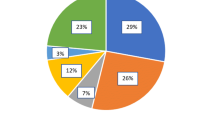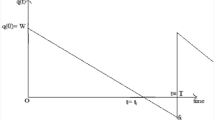Abstract
We analyze an inventory system with a mixture of backorders and lost sales, where the backordered demand rate is an exponential function of time the customers wait before receiving the item. Stockout costs (backorder cost and lost sales cost) include a fixed cost and a cost proportional to the length of the shortage period. A procedure for determining the optimal policy and the maximum inventory profit is presented. This work extends several inventory models of the existing literature.
Similar content being viewed by others
References
Abad, P. L. (1996). Optimal pricing and lot-sizing under conditions of perishability and partial backordering. Management Science, 42, 1093–1104.
Abad, P. L. (2001). Optimal price and order size for a reseller under partial backordering. Computers & Operations Research, 28, 53–65.
Abad, P. L. (2003). Optimal pricing and lot-sizing under conditions of perishability, finite production and partial backordering and lost sale. European Journal of Operational Research, 144, 677–685.
Abad, P. L. (2008). Optimal price and order size under partial backordering incorporating shortage, backorder and lost sale costs. International Journal of Production Economics, 114, 179–186.
Balkhi, Z. T. (2000). On the optimal production stopping and restarting times for an EOQ model with deteriorating items. The Journal of the Operational Research Society, 51, 999–1001.
Balkhi, Z. T., Goyal, S. K., & Giri, B. C. (2001). Some notes on the optimal production stopping and restarting times for an EOQ model with deteriorating items. The Journal of the Operational Research Society, 52, 1300–1301.
Chang, C. T., Goyal, S. K., & Teng, J. T. (2006). On “An EOQ model for perishable items under stock-dependent selling rate and time-dependent partial backlogging” by Dye and Ouyang. European Journal of Operational Research, 174, 923–929.
Chern, M. S., Chan, Y. L., & Teng, J. T. (2005). A comparison among various inventory shortage models for deteriorating items on the basis of maximizing profit. Asia-Pacific Journal of Operational Research, 22, 121–134.
Chu, P., & Chen, P. S. (2002). A note on inventory replenishment policies for deteriorating items in an exponentially declining market. Computers & Operations Research, 29, 1827–1842.
Chu, P., & Chung, K. J. (2004). The sensitivity of the inventory model with partial backorders. European Journal of Operational Research, 152, 289–295.
Dye, C. Y. (2007). Joint pricing and ordering policy for a deteriorating inventory with partial backlogging. Omega, 35, 184–189.
Dye, C. Y., & Ouyang, L. Y. (2005). An EOQ model for perishable items under stock-dependent selling rate and time-dependent partial backlogging. European Journal of Operational Research, 163, 776–783.
Dye, C. Y., Hsieh, T. P., & Ouyang, L. Y. (2007). Determining optimal selling price and lot size with a varying rate of deterioration and exponential partial backlogging. European Journal of Operational Research, 181, 668–678.
Ghosh, S. K., & Chaudhuri, K. S. (2005). An EOQ model for a deteriorating item with trended demand and variable backlogging with shortages in all cycles. Advanced Modelling and Optimization, 7, 57–68.
Giri, B. C., Jalan, A. K., & Chaudhuri, K. S. (2005). An economic production lot size model with increasing demand, shortages and partial backlogging. International Transactions in Operational Research, 12, 235–245.
Jolai, F., Tavakkoli-Moghaddam, R., Rabbani, M., & Sadoughian, M. R. (2006). An economic production lot size model with deteriorating items, stock-dependent demand, inflation and partial backlogging. Applied Mathematics and Computation, 181, 380–389.
Lee, H. L., & Nahmias, S. (1993). Single-product single-location models. In S. C. Graves, A. H. C. Rinnoy, & P. H. Zipkin (Eds.), Handbooks in operations research and management science, logistics of production and inventory (Vol. 4, pp. 3–55). Amsterdam: North-Holland.
Leung, K. N. (2008). Technical Note: A use of the complete squares method to solve and analyze a quadratic objective function with two decision variables exemplified via a deterministic inventory model with a mixture of backorders and lost sales. International Journal of Production Economics, 113, 275–281.
Lo, S. T., Wee, H. M., & Huang, W. C. (2007). An integrated production-inventory model with imperfect production processes and Weibull distribution deterioration under inflation. International Journal of Production Economics, 106, 248–260.
Mak, K. L. (1987). Determining optimal production-inventory control policies for an inventory system with partial backlogging. Computers & Operations Research, 14, 299–304.
Montgomery, D. C., Bazaraa, M. S., & Keswani, A. K. (1973). Inventory models with a mixture of backorders and lost sales. Naval Research Logistics Quarterly, 20, 255–263.
Pal, A. K., Bhunia, A. K., & Mukherjee, R. N. (2006). Optimal lot size model for deteriorating items with demand rate dependent on displayed stock level (DSL) and partial backordering. European Journal of Operational Research, 175, 977–991.
Papachristos, S., & Skouri, K. (2000). An optimal replenishment policy for deteriorating items with time-varying demand and partial—exponential type—backlogging. Operations Research Letters, 27, 175–184.
Park, K. S. (1982). Inventory model with partial backorders. International Journal of Systems Science, 13, 1313–1317.
Pentico, D. W., & Drake, M. J. (2009). The deterministic EOQ with partial backordering: A new approach. European Journal of Operational Research, 194, 102–113.
Pentico, D. W., Drake, M. J., & Toews, C. (2009). The deterministic EPQ with partial backordering: A new approach. Omega, 37, 624–636.
Rajan, A., Rakesh, & Steinberg, R. (1992). Dynamic pricing and ordering decisions by a monopolist. Management Science, 38, 240–262.
Rosenberg, D. (1979). A new analysis of a lot-size model with partial backlogging. Naval Research Logistics Quarterly, 26, 349–353.
San-José, L. A., Sicilia, J., & García-Laguna, J. (2005a). An inventory system with partial backlogging modeled according to a linear function. Asia-Pacific Journal of Operational Research, 22, 189–209.
San-José, L. A., Sicilia, J., & García-Laguna, J. (2005b). The lot size-reorder level inventory system with customers impatience functions. Computers & Industrial Engineering, 49, 349–362.
San-José, L. A., Sicilia, J., & Garcia-Laguna, J. (2006). Analysis of an inventory system with exponential partial backordering. International Journal of Production Economics, 100, 76–86.
San-José, L. A., García-Laguna, J., & Sicilia, J. (2009a). An economic order quantity model with partial backlogging under general backorder cost function. Top, 17, 366–384.
San-José, L. A., Sicilia, J., & García-Laguna, J. (2009b). A general model for EOQ inventory systems with partial backlogging and linear shortage costs. International Journal of Systems Science, 40, 59–71.
Skouri, K., & Papachristos, S. (2002). A continuous review inventory model, with deteriorating items, time-varying demand, linear replenishment cost, partially time-varying backlogging. Applied Mathematical Modelling, 26, 603–617.
Wu, K. S., Ouyang, L. Y., & Yang, C. T. (2006). An optimal replenishment policy for non-instantaneous deteriorating items with stock-dependent demand and partial backlogging. International Journal of Production Economics, 101, 369–384.
Yan, H., & Cheng, T. C. E. (1998). Optimal production stopping and restarting times for an EOQ model with deteriorating items. The Journal of the Operational Research Society, 49, 1288–1295.
Yang, G. K. (2007). Note on sensitivity analysis of inventory model with partial backorders. European Journal of Operational Research, 177, 865–871.
Zeng, A. Z. (2001). A partial backordering approach to inventory control. Production Planning & Control, 12, 660–668.
Author information
Authors and Affiliations
Corresponding author
Rights and permissions
About this article
Cite this article
Sicilia, J., San-José, L.A. & García-Laguna, J. An inventory model where backordered demand ratio is exponentially decreasing with the waiting time. Ann Oper Res 199, 137–155 (2012). https://doi.org/10.1007/s10479-011-0944-x
Published:
Issue Date:
DOI: https://doi.org/10.1007/s10479-011-0944-x




